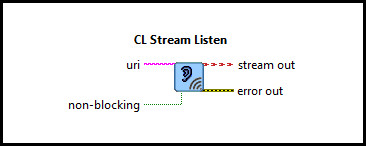
CL Stream Listen

| Owning Palette: | Communications/Advanced |
| Requirements: | Quanser Rapid Control Prototyping Toolkit, LabVIEW 2020 or newer, Control Design and Simulation Module |
Description
The CL Stream Listen VI creates a stream that listens for connections from remote hosts. The stream is created each time the VI executes. Streams have two modes: blocking (the default) and non-blocking. This VI returns immediately regardless whether the stream is blocking or non-blocking.
Optional Inputs or Dialog Box Options  Optional inputs need not to be wired. They may appear as terminals or dialog parameters, but show up as dialog parameters by default.
They are indicated but not labelled in the context help window for the VI.
Optional inputs need not to be wired. They may appear as terminals or dialog parameters, but show up as dialog parameters by default.
They are indicated but not labelled in the context help window for the VI.

|
uri identifying the communication channel upon which to listen for connections from remote hosts, and the associated communication parameters. For example, tcpip://localhost:18000?backlog=10 listens for connections on TCP/IP port 18000 and allows up to 10 client connections to be queued while awaiting acceptance by a CL Stream Accept VI. |

|
Non-blocking, check this port to make the stream non-blocking. In this case, all VIs using
the stream become nonblocking; this VI will return immediately but any
CL Stream Accept VI using this stream will not wait for a connection
to be accepted. Instead, whenever the CL Stream Accept
VI would otherwise wait, the error code |
Outputs

|
stream out reference to the stream. This reference is always valid but will not refer to a listening stream if the stream could not be created. It has a data type of t_stream_ptr. It cannot be plotted and may only be connected to the stream out input of one of the Stream VIs. It may not be connected to a CL Stream Send, CL Stream Flush or CL Stream Receive VI. Attempting to do so will result in an error being returned by that VI. |
||||||

|
error out contains error information. If the error in cluster indicated an error, the error out cluster contains the same information. Otherwise, error out describes the error status of this VI.
|
Details
The CL Stream Listen VI creates a stream that listens for connections from remote hosts. The stream is created each time the VI executes. Streams have two modes: blocking (the default) and non-blocking. This VI returns immediately regardless whether the stream is blocking or non-blocking.
However, in non-blocking mode, any CL Stream Accept
VI using the stream will also be non-blocking. Furthermore,
connections accepted from remote hosts will be non-blocking. Whenever a CL Stream Accept VI
would otherwise wait, the error code -QERR_WOULD
is returned instead. When combined with a state machine, non-blocking mode is suitable
for periodic tasks because it does not interfere with the sampling rate.
The CL Stream Poll
VI may be used to wait or poll for a connection to be accepted or other events.
If the stream is created successfully then the stream out output refers to the connected stream. This stream signal is passed as an input to CL Stream Accept VIs to refer to the stream. In this case, the error out output will be zero.
If the stream could not be created then the error out output will be a negative error code. The stream out output is never zero, even when the stream cannot be created, because it is a reference to the stream rather than the stream handle itself. Hence, it cannot be used directly to determine whether the stream is valid.
The communication channel used for streams is identified by a Universal Resource Identifier (URI), such as tcpip://localhost:18000 or serial://localhost:1?baud=57600. RCP uses URI's for all its communications because it provides a uniform, extensible and flexible means of identifying the communication protocol to use and the associated communication parameters. Refer to Universal Resource Identifiers for more information.
When the URI is specified as a dialog parameter and is not evaluated then the URI is configuration-dependent.
| When using the UDP protocol, the network interface card (NIC) from which datagrams are received may be specified using the nic option. Refer to the UDP Protocol for details. Unlike other protocols, it is also possible for two CL Stream Listen VIs to communicate with each other rather than requiring a CL Stream Listen and CL Stream Connect VI. |
Feedthrough Behaviour
All input/output pairs of this function have direct feedthrough behaviour.
Examples
| RCP CL Comm Advanced Stream Example |
See Also
| CL Stream Close | ||
| CL Stream Connect | The CL Stream Connect VI establishes a connection to a remote host. The connection is made each time the VI executes. | |
| CL Stream Flush | ||
| CL Stream Accept | ||
| CL Stream Poll |
Targets
|
Target |
Supported |
Comments |
|---|---|---|
|
Yes |
Fully supported. |

Copyright © Quanser Inc. This page was generated 2021-09-24. Submit feedback to Quanser about this page.
Link to this page.



